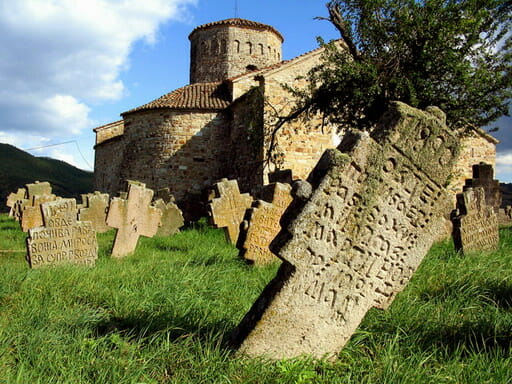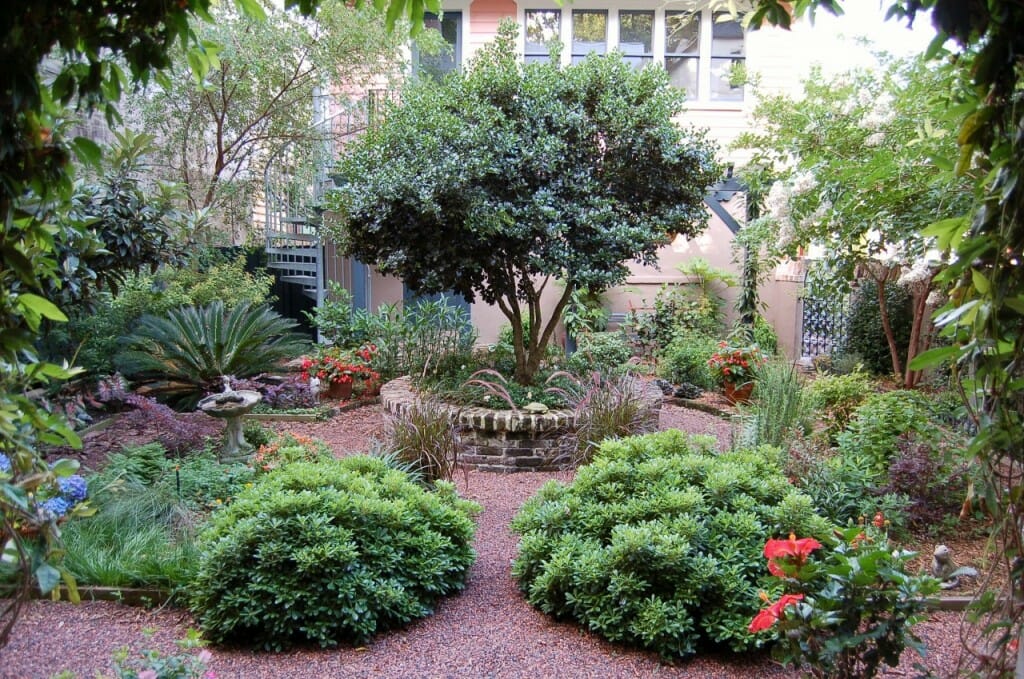Similar Posts
This is the eleventh part of an ongoing serial (part 1, part 2, part 3, part 4, part 5, part 6, part 7, part 8, part 9, part 10)
The vision of paradise as an idyllic walled garden is exceedingly ancient and universal. For thousands of years, palaces have been built around courtyard gardens, and the ancient kings lived out their reigns in an artificial landscape of ideal beauty – an icon of the natural world transfigured into paradise. There is a very old belief that any garden represents a restoration of Eden, and from the earliest times palace gardens have specifically imitated certain characteristics of Eden. The garden was always square. A fountain at the center poured forth water into four channels that radiated outward in the cardinal directions – an image of the four rivers of paradise referenced in Genesis 2:10-14. This archetypical design is originally of very ancient Persian origin (as is the word paradise itself). Almost universal, it influenced the form of gardens in Rome, Byzantium, the Arab Caliphates, the Persian empires in India, and the medieval kingdoms of Western Europe.

A Western European garden which recalls the cross-in-square archetype of paradise. Alcazar Palace, Cordoba, Spain
Given the rich symbolic history of gardens, how do they fit into the iconic expression of the kingdom of God as liturgical art? To understand the complex relationship between an Orthodox temple and its surrounding landscape, we must first consider this: We are no longer naked in the garden, like Adam and Eve. The Garden of Eden had at its center the Trees of Life and Knowledge, but the Orthodox garden has a church in its midst, the new font of life and knowledge. The whole of the grounds of a church is the territory of the Kingdom of God. To enter through the churchyard gate is to pass into a different world. To walk through the gardens to church is to begin the joyous ascent up the mountain to meet our Lord who sits enthroned in New Jerusalem.
In desert countries, the ancient church gardens have a marvelous separation from the surrounding landscape. A monastery in Egypt or Palestine is like an ark of paradise moored in the ocean of dry sand. After a long journey through a landscape of desolation, we see palms rising above the high walls. Inside are flowers and birds and fragrant smells. Even in countries with more verdant climes, the separation of the church gardens from the surroundings was considered very important. Whether by tall wall, or merely a fence with a gate, a church’s grounds were always set apart from the fallen world, and all within would radiate with the beauty of life.
In contrast, the natural landscape of Russia seems innately paradisiacal. Due to the long hours of summer daylight, flowers grow to astonishing size and with incredible profusion, every meadow looking like a thriving garden. Perhaps this contributed to the idea of ‘Holy Russia’, a notion that the whole country is sanctified. Indeed, Russia’s verdant landscape is dotted with churches as though the nation itself is a church garden. And Russian church processions routinely travel great distances, from one village to another, through fields and forests. In a way, this is the ideal image of the Kingdom of God – the beauty of the church spreading out into all the Earth.
But an Orthodox nation takes centuries to build, and a sanctified landscape grows ever further out of reach with the ecological vandalism of modern times. Today, most Orthodox churches are like the monastery in the desert, a lonely outpost amidst desolation and banditry. For modern people, a beautiful church garden is of the greatest importance. Most people must come to church by car, traveling at unpeaceful speed through an ugly landscape. Only by leaving our cars and passing through a churchyard gate can we mentally escape the banality of the fallen world. The short stroll through the garden to the church allows us a moment to recollect the beauty of God’s creation and the peace of His presence. The sight of flowers and the songs of birds re-center our attention on the beauty of Life, and away from the hectic pressure of modernity.
After providing comfort in life, a churchyard provides comfort in death. A church is traditionally surrounded by graves. How beautiful to see the faithful symbolically laid to rest in eternal paradise! How wonderful that the dead gather around God’s temple along with the living! The presence of graves is always a great blessing to a church garden, but the design of the graves is not inconsequential. Modern granite headstones have a cold perfection that is machine-like and alien to a living garden. They look best in military rows amidst flawless mown grass. The graves in a church garden must harmonize with the natural plants and rocks. Traditional grave markers are simple crosses made from wood or natural-cleft slabs of stone. They are unimposing and grow more beautiful as they age and decay. They stand in a garden like hermit monks, wise and silent, greeting visitors with only the sign of the cross. In some countries, the little plot where the departed lies is built up with a stone curb and made a miniature garden of its own – a sign that the beloved has become part of paradise, and an opportunity for the living to show remembrance by tending the little garden.
How should a church nowadays go about designing the landscape around the temple? In ancient times, Byzantine churches always had forecourts, and these contained fountains where the faithful washed themselves before entering. (Mosque architecture still imitates this Byzantine model very closely.) But I would suggest that nowadays, in our modern civilization, where showers are plentiful but peace is rare, a different type of cleansing is needed. Modern people arrive to church well bathed, but with unquiet minds. Let us today build forecourts to our churches that contain beautiful gardens. They should be well-bounded with walls or hedges to screen off the distractions of the fallen world. There our senses can refocus on the sights, sounds, and smells of real and natural life. For only having laid aside all earthly cares can we begin our long ascent into God’s Kingdom.

Proposed design for an Orthodox church in Plano, Texas, by the author. Because the site lies along a highway, I proposed to enclose it in a tall wall to shelter the gardens from the view and sound of traffic.

A garden in the style of the medieval west, The Cloisters, NY. These geometrical courtyard gardens are an excellent model for Orthodox churchyards.

A master plan for Saint Michael Skete, New Mexico, designed by the author. The buildings frame courtyard spaces subdivided into raised garden beds following the ancient cross-in-square geometry.

A paradise garden with central fountain feeding four water channels, Alhambra Palace, Granada, Spain. 14th century.












Your insight into the garden and the fountain and its relation to paradise is wonderful, and it is fascinating to see how the cross related to the four directions/rivers is so universal in meaning. It can help us to see how the cross shape of the church building also signifies the world itself in that way, the world in its “extension” we could say. Thanks for this.
Andrew. this is a very revealing article about planting paradise, something I have experienced in so many places, but never heard it articulated in such a clear and elevating manner as you have described it. The strongest experience I have in my memory was at St. Mary Magdalen Monastery on the Mount of Olives. The tension in Jerusalem was so heavy in October 2008, but when I passed through the gates into the monastery gardens it was truly a premeditated paradise for cats and birds and flowers and trees and nuns and pilgrims.
Thank you,
Mary
I really enjoyed this article, not just because I have been to the Cloisters in NY and loved it, and hope to someday see many of the other examples pictured — but because it was so enlightening to learn the historical and theological reasons for the walled Mediterranean garden. I have always loved these gardens, they are common among some of the larger Spanish style estate properties here, but now I know why I love them.
In our back yard, a few years ago we ripped out all the grass and replaced it with a similar type of garden, with a small fountain in the center, surrounded by CA and Mediterranean herbs and perennials. Our garden was too small and oblong to do a cross in square, so we have rectangular beds and DG paths in between. At the time we did it, we wondered if we would regret having no grass in the back. But I have never looked back. My studio faces the garden, and I like to watch the birds flit around drinking the water from the fountain and feeding on the seed heads from the sage plants that surround it.